Three-day International Seminar
on
“Islamic Culture and Art”
December 30-31, 2011 and January 1, 2012
Hyderabad
Organised by
Institute of Objective Studies
Maulana Azad National Urdu University (MANUU) Hyderabad
MESCO CADRE, Hyderabad
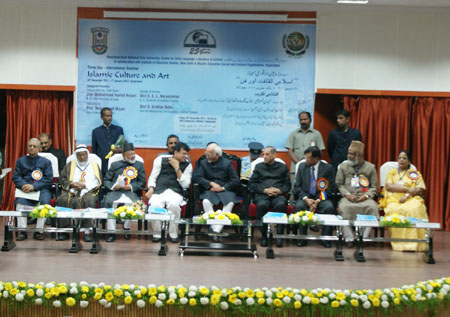
L-R: Prof. A.R. Momin, Editor, IOS Minaret, Mumbai; Prof. Mohammed Jamil bin Ali Al-Khayat, Asst. Secretary General, World Muslim League, KSA; Dr. Mohammad Manzoor Alam, Chairman, Institute of Objective Studies, New Delhi; Shri D. Saridhar Babu, Hon'ble Minister for Civil Supplies, Andhra Pradesh; Shri Mohammad Hamid Ansari, H.E. Vice President of India; Shri E.S.L. Narasimhan, H.E. Governor of Andhra Pradesh; Prof. Mohammad Miyan; Vice-Chancellor, MANUU, Hyderabad; Dr. Fakhruddin Mohammed, Honorary Secretary, MESCO, Hyderabad; Prof. H. Khatija Begum, Registrar, MANUU, Hyderabad
3-day IOS International Seminar at MANUU on “Islamic Culture and Art”
Hyderabad, December 30: A three-day international seminar on “Islamic Culture and Art” began here today at the Maulana Azad National Urdu University (MANUU) with recitation from the holy Quran. Prof. Wahab Qaisar formally welcomed the delegates and participants. The seminar was jointly organised by the Institute of Objective Studies (IOS), MESCO and MANUU.
In his address the IOS Chairman Dr Mohammad Manzoor Alam explained the main theme of year-long IOS Silver Jubilee Celebrations, “Knowledge, Development and Peace”, from which sub-themes emanated for 14 seminars and conferences that were, and would be, held at different locations in India. The Hyderabad seminar was the ninth in the series.
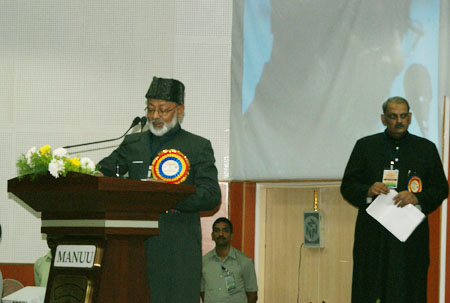
Speaker: Dr. Mohammad Manzoor Alam, Chairman, Institute of Objective Studies, New Delhi
Dr Alam announced the establishment of an IOS Centre for Islamic Culture and Arts at Hyderabad in days ahead. He said the foundation stone of the proposed Objective University being planned by the IOS would be laid in 2012 at Palwal in Haryana just outside Delhi.
The Governor of Andhra Pradesh, ESL Narasimhan, mentioned the extraordinary contribution of Islam to arts, mathematics and medicine, among other areas of life. “Islamic art draws from nature”, he said.
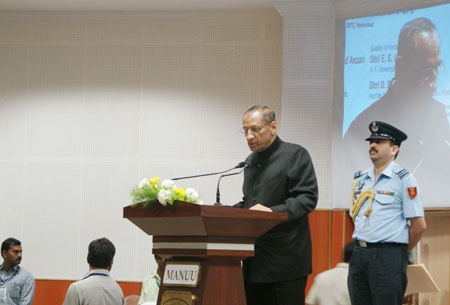
Speaker: Shri E.S.L. Narasimhan, H.E. Governor of Andhra Pradesh
He referred to the composite culture of India, built over centuries by Hindus, Muslims and other Indians. The great Mughals were instrumental in the development of composite culture in which different elements coalesced and blended to give birth to the magnificent phenomenon called the Indian culture. Such a fine harmony was symbolised by the Taj Mahal in which marble was inlaid with precious stones, which showed India’s rich cultural heritage.
He said, culture, a celebration of the senses, did not stand in isolation, but was composed of different elements and those elements could not be separated from one another.
In his keynote address Prof. A.R. Momin, former head of Sociology, University of Bombay, said centuries of Muslim rule in Hyderabad had introduced Islam not just as a faith and a set of rituals but as a repository of cultural values, a fine moral code and social institutions as well. It was part of a cultural landscape spreading from Atlantic to South Asia, Africa to China.
Delivering the keynote address Dr Hamid Ansari, Vice-President of India, referred to the nebulous past of India, where over millennia different races, with their own belief systems and ways of life, came down to settle.
This led to creation of “layers upon layers of culture,” he said, referring to Dr Tarachand’s observations regarding multiplicity of sources of Indian culture.
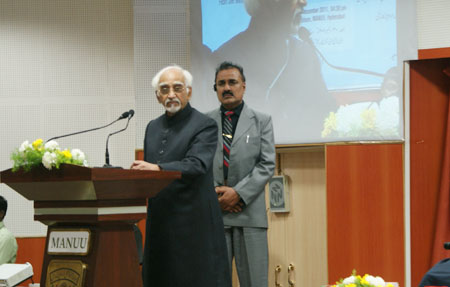
Speaker: Shri Mohammad Hamid Ansari, H.E. Vice President of India
Dr Ansari cited anthropologist Edward Teller’s views on culture as “a complex fold of belief, knowledge and practices and as a dialogue between religious experience and the realm of reality.”
He said literature, architecture, philosophy and painting reflected culture. Under Muslim rule, most of the time the state was not theocratic and state organisations made laws, not Islam. All this happened in a melieu which, as al-Beiruni saw it, preferred to “relate, not criticise.”
Towards the 12th century AD a new architecture developed, the landscape architecture of Ahmedabad, Mandu, Hyderabad and other places.
Persian and Hindu artists came together to create records of India’s flora and fauna through painting during the rein of Jehangir, who was a connoisseur of arts. It was then that “aesthetic became a marker of sovereignty.”

A view of audience
He referred to Baburnama, Tuzk-e-Jahangiri and Humayunama to make the point. In the construction of the edifice of India’s Ganga-Jamuni culture, sufis, “who sought commonality,” played a significant role. Dara Shikoh, Aurangzeb’s brother, who mingled with sufis and bhaktas, wrote Majmu-e-Bahrain (Confluence of Rivers) emphasising the syncretic nature of Indian culture. Dr Ansari also referred to Dr Tarachand’s Impact of Islam on India in support of his views.
A vote of thanks was proposed by Dr Fakhruddin Mohammad, a physician and educationist from Hyderabad.
Day-2
The first session, chaired by Prof. Vinod Jairath, had “Islam and Pluralistic Society” as its theme. Dr Shafique Ahmad Shaikh, assistant registrar, MANUU, asserted that right from the beginning the Islamic state had tried to create and promote a pluralistic society. This trend was visible in the treaty Muslims concluded with the Jews and Christians of Medina on the establishment of the first Muslim state. The same trend was visible from Arab Spain (Andalusia) to Mughal India.
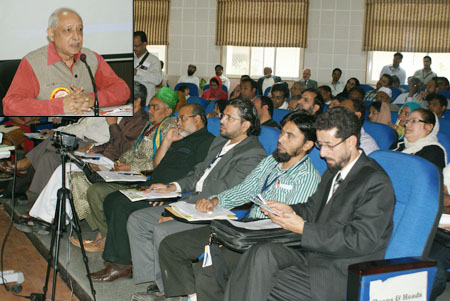
Prof. Vinod Jairath delivering his presidential remarks
In his paper on “Influence of Muslims on Indian Society,” Syed Islamuddin Mujahid (reader, Urdu Deptt., Arts [Evening] College, Hyderabad) quoted from Dr Tarachand to point out that every aspect of Indian life was touched and influenced by Muslims. Historian Jadunath Sarkar wrote that the fair and just order created by Muslims would not be ignored by any historian. “Sher Shah strictly enforced the equality of all religions,” he said, and quoted Punjab Kesari Lala Lajpat Rai’s remark that Muslims had been fair to Hindus.
Dr Mujahid quoted from the Discovery of India by Pandit Jawaharlal Nehru to assert that Muslim rulers integrated India as they considered themselves to be Indian. They regarded India as a free country and every Indian as free. They tried to protect every Indian life. That was why Shahjehan’s rule witnessed very few cases of sati. To make the burning of women on the pyres of dead husbands difficult permission of the governor had to be obtained. The governor discouraged the practice and ensured state’s help to the widow and her children.
Dr Syed Fazlullah Mukarram (associate professor, Oriental Urdu PG college, Himayat Nagar, Hyderabad) made an elaborate presentation on the contribution of the Qutubshahi rulers to the development of Telugu language and literature.
The second session, jointly chaired by Prof. Afzal Wani and Dr Mazhar Hussain, was devoted to the same theme as the one preceeding it.
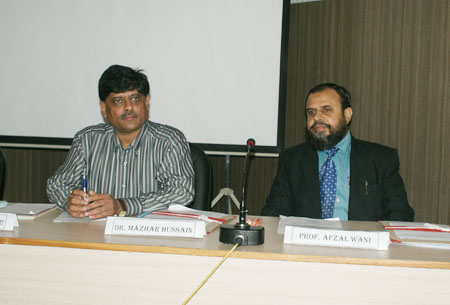
This session jointly chaired by Prof. Afzal Wani and Dr Mazhar Hussain
Dr GN Khaki (associate professor, Islamic Studies, University of Kashmir) talked on “Cultural Interaction Between Central Asia and India: Studying the Role of Islam.” His central point was that trade, the pursuit of scholarship, migration and Muslim diaspora led to the spread of Islam across the known world.
Dr Nikhat Jahan (associate professor, Distance Education, MANUU) presented a paper on composite culture as represented in Urdu marsiya (elegy).
Sufis, bhaktas and their khanqahs and dargahs created an eclectic ambiance conducive to cross-fertilisation of religious ideas. Muslims wrote songs on Indian spring and other themes and Hindu poets euologised Muslim religious figures. “In Andhra Pradesh, farmers tilling the land and weavers working at their looms sing these marsiyas,” she said, emphasising the popularity and endurance of that genre of poetry.
Composite culture was a long time in the making. Assamese Muslims fought Afghans and Persians on the side of the Hindu Ahom rulers near Gauhati in 1498, Sazzad Hussain from Lakhimpur college in Assam said in his “Muslims in Assam: The Way Forward”. A Muslim warrior, Bagh Hazarika, fought Mughals in 1671.
Shah Meeran-Azam Peer’s zikr was based on the hymns of Sankardev’s (17th century) tradition. The mutual enrichment picked up pace after the influx of Bengalis from Mymensingh (now in Bangladesh) to Assam in the 19th century. Better-trained and organised farmers as they were, they were brought in by the British to cultivate the vast tracts of fallow lands in Assam and thus contribute to increase in government revenue.
Mr Hussain also referred to the “anti-foreigners movement” of the 1970s and the horrible massacre of Muslims at Nellie, which he described as “the only known massacre of Muslims in Assam.” One-third of Assam being Muslim, Islam, naturally, has a highly visible presence there.

Dr. Ausaf Ahmad and Mr. Sajjad Shahid jointly chaired the session
Jafar Sadiq of English department ( Centre for English and Foreign Languages, Hyderabad) in his paper on “Muslim Art and Cultural Forms in Kerala” said that Muslim contribution had been of an “integrative, yet sharply distinct”, nature.
In the next session Nanak Singh Nishter (director, International Sikh Centre for Interfaith Relations, Hyderabad) talked about “Similarities Between Sikhs, and Muslims” and the shared common ground between different religions.
In the Guru Granth Sahab, the works of seven Muslims and two untouchables figure. This holy text strongly supports namaz (salat), he said.
He said several Hindu kings resisted Guru Gobind Singh, who was firmly supported by a Muslim peer at a great personal cost. As a gesture of reconciliation, Sikhs handed over a gurudwara to Muslims in 2003 to be converted into a mosque.
Mr. Shabeer Ahmad Taing, a research scholar in the department of English, MANUU, talked about composite culture and Indian society with reference to Muslim contribution. He cited the specific rishi-sufi tradition of Kashmir that created a melieu for Hindus and Muslims to blend “like milk and sugar.”
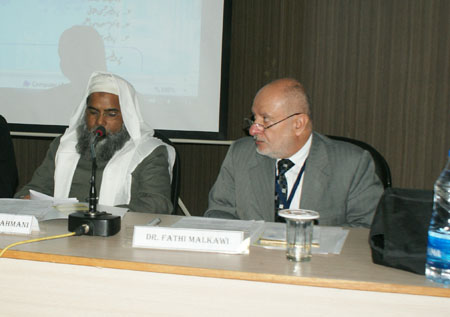
Maulana Khalid Saifullah Rahmani, Hyderabad and Dr. Fathi Hasan Malkawi, Regional Director, International Institute of Islamic Thought, Jordan jointly chaired the session
The next session, jointly presided by Dr Syed Taqi Abedi and Prof. Mohsin Usmani, had “Islam and Sufism” as its theme. Shah Mohammad Shahid Ahmed Siddiqui, mutwalli Aastanay-e-Ghausiya, Warrangal, talked about sufi movement in India from his own experience as the head of a sufi dargah. He emphasised the pro-people stance of sufis. “Islam and peace are synonymous”, he declared. He traced the origin and growth of Sufism through India, the Subcontinent and Asia as a whole.
Dr Scott Kugle of Emory University, Deptt. of Middle Eastern and South Asian Studies, made a presentation on “Siraj Aurangabadi: Sufi Master, Qawwali Patron and Urdu Poet.” Aurangabadi fell madly in love with a woman and “mixed the romantic with the mystic.” Almost a contemporary of Wali Dakkani, who went to Delhi, Siraj Aurangabadi never left Deccan. He was pioneer of Urdu ghazal as Amir Khusro was of Hindi ghazal. Dr Kugle sang one of Aurangabadi’s ghazals to great acclaim.
Dr Syed Alim Ashraf Jaisi, assistant professor, department of Arabic, MANUU, presented a paper on the sufi movement against colonialism in the context of North Africa.
Sufis, Dr Jaisi said, were often war heroes. Chazzali, Abdul Qadir Jilani and Salahuddin Ayyubi were both sufis and warriors, he asserted, quoting historian Khaliq Ahmad Nizami.
Ibne-e-Khaldun too had similar views. He mentioned the two-and-a-half century old Central Asian and Caucasian Muslims’ struggle against Russian colonialism. From Egypt to Somalia, sufism is synonymous with Islam and it has worked as vanguard in the struggle for independence from colonial rule. Imam Shafei used to volunteer as a guard from morning to night. Sanussi sufis led the north African people in their struggle for independence from Western colonial rule, Dr Jaisi said.
In his paper on Sufism and Mathnavi Maulana Rum Dr Mohammad Abdul Hameed Akbar said that sufism drew from the Quran and Hadith and thus was not antithetical to doctorial Islam as commonly believed.
In his presidential address Dr Syed Taqi Abidi said that Islam had come to unite, not divide. He recited the Persian couplet: Tu barai wasl kardan amadi / na ke barai fasl kardan amadi (You, Muslims, have come to unite, not to divide).
Day-3
The first session of the last day, devoted to “Islamic Art and Calligraphy”, was chaired by Dr Mohammad Ziauddin Shakeb.
Dr Mohammad Shujath Ali, deputy director, CPDUM, MANUU, Hyderabad, spoke on the “Multiple Forms of Indian Art: The Art of Music,” while Dr Habib Nisar, Department of Urdu, HCU, Hyderabad, chose to speak on the “Role of Amir Khusro in the Development of Indian Music.” Mohammad Muneer, MA Women’s Studies, MANUU, Hyderabad’s paper was on “Calligraphy as an Islamic Art.”
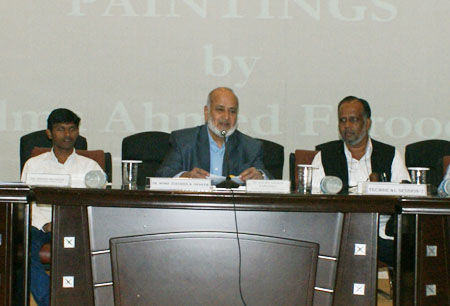
Chairman of the session Dr. Mohd. Ziauddin A. Shakeb
Dr Salma Ahmad Farooqui, associate professor DDE, MANUU, Hyderabad, presented a paper on “The Making of Mughal Art—From Islamic to Un-Islamic: An Analysis of Paintings.”
She said Mughals brought numerous art forms to India, mainly of Persian origin. Emperor Akbar, who wanted to rule over the whole of India, made a departure from the Shariah to suit his goals.
He built up the power of the state with an elaborate apparatus, created a suitable political culture in which different religious sections and ethnic groups found a place. A wide array of nobles and religious figures, including Ulema, were accommodated. A sizeable number of non-Muslims were given important positions in the administration. With Sulah-e-Kul and Deen-e-Ilahi he secularised the polity.
Muslim painters showed ancient Indian motifs. These were distinctly Indian. There was no codification of laws. Muslims generally avoided painting as it was seen to be imitating God’s creativity. During Babur’s rule Chinese influence came via Persia as is evident from the features of the figures painted during that era. “The Mughal version of art was essentially Indian”, she asserted.
Under Akbar important texts were illustrated. Shahnama, Tutinama and Baburnama were among the major texts thus illustrated. Abdus Samad trained many Hindu painters. Under Jehangir painters like Abul Hasan and Ustad Mansur flourished.
“Sensuality has been celebrated in India”. This trend came into Mughal painting during Shahjehan’s time. Under Aurangzeb’s rule it was not encouraged, but continued nonetheless in his youth, middle age and old age.
Ali Asghar Mullazehi talked on “Art and the Spiritual in Islamic Aesthetics”. He said great Persian poets like Hafiz, Saadi and Rumi recognised the legitimacy of image-making. Geometrical patterns could have unlimited variants, suggesting infinity. “Through the finite a geographical pattern suggests the infinite”, he pointed out. Ishraqi held that realistic representation led to the imagining of what is beyond the known and familiar.
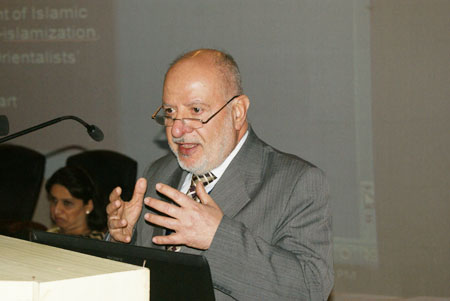
Dr. Fathi Hasan Malkawi, Regional Director, International Institute of Islamic Thought, Jordan
Dr. Fatahi al-Maakawi elaborated upon the “Manifefestation of Tawhid in Islamic Art: Theory of Ismail Raji al-Faruqi”.
Valedictory Session
Syed Zakir Hussain, Member Salar Jung Museum, Hyderabad, welcomed the guests effusively.
A rapporteur’s version of the highlights of the seminar was presented by Dr Prof. Khalid Saeed, director-in-charge, CULLIC, and orgnaising secretary of the seminar.
Prof. Afzal Wani, professor of law, IP University, Delhi, and member governing council, IOS, presented a draft resolution of the seminar.
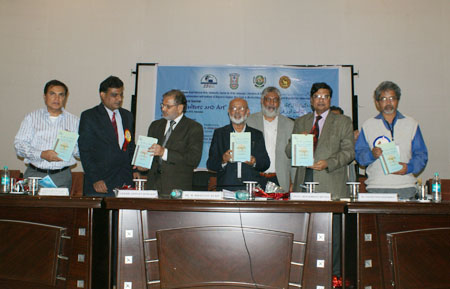
A view of release the book "The Role of Muslims in the Indian Freedom Struggle 1857-1947" by Dr Shawkatullah Khan
The guest of honour, Dr Tajuddin Ahmad, in his address pointed out that Islamic art and culture was not confined to India or the Sub-continent alone, but was visible worldwide, across continents.
The chief guest, Jannat Husain, IAS, Chief Information Commissioner of Andhra Pradesh, endorsed the views presented at the seminar over the last three days.
In his valedictory address, MANUU vice-chancellor Prof. Mohammad Miyan, lauded the accomplishments of IOS, its staff and chairman, Dr Mohammad Manzoor Alam. Prof. Miyan, Dr Alam and Mr Jannat Hussein being the alumni of Aligarh Muslim University, he referred to the love for the alma-mater that had given them a sense of kinship and common perspective on life.
Institutions survived the individuals who built and supported them. Thus, he said, institutions mattered more.
Coming back to the IOS, he said that it had worked tirelessly over the last quarter century for the cultural integration of India. It had been working for its goals through interaction with government and society.
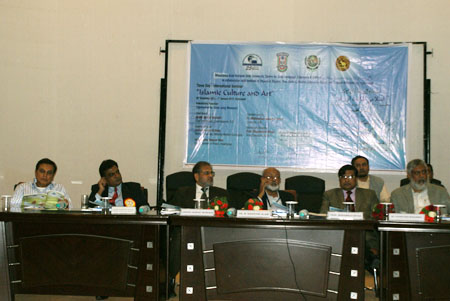
Valedictory session chaired by Dr. Mohammad Manzoor Alam, Chairman, IOS
He stressed the need for large-heartedness and concern for people from all sections of society. “This is how sufis helped the cultural integration of India”. That, he concluded, was the way to go.
In his presidential address Dr Mohammad Manzoor Alam highlighted the nationwide programmes held in the IOS Silver Jubilee Year. “It was the ninth such programme”, Dr Alam said regarding the Hyderabad conference.
Dr Alam informed the large audience that the concluding programme to be held in April 2012 in New Delhi would be on minorities and one of the issues to be deliberated would be the backwardness of Indian Muslims in higher education.
Finally, he invited the audience, and through them the people of India, to “come together, sit together, think together, work together”.
Prof. Khalid Sayeed proposed a vote of thanks.
The following were awarded at the seminar over three days:
- Dr Rahimuddin Kemal
(for his Contributions to Learning – Writings: Philosophy, Law, Culture)
- Prof Sadiq Naqvi
(for his contribution to Learning- History)
- Mr M A Qaiyum
(for his contributions to Archaeology- Conservation of Monuments & Writings)
- Ms Lakshmi Devi Raj
(for her contributions to Culture- Museology / Revival of Art forms: textiles)
- Pandit Vithal Rao
(for his contributions to Art – Performing Arts: Music/ Ghazal singer)
- Ms P. Anuradha Reddy
(for her contributions to Culture- Heritage conservation Activist, Writer: History, Photographer: Cultural Assets)
- Sahibzada Mir Azmat Ali Khan
(for his contributions to Islamic Art- Sketches and drawings of monuments)
- Mr K O Qarni
(for his contribution to Art: Paintings and Sketches of monuments, restoration of paintings)
- Prof. Mohsin Usmani Nadvi
Dean, Arab Studies, The English and Foreign Languages University, Hyderabad
- Prof. Khalid Saeed
Director Incharge, CULLC, MANUU, Hyderabad
- Mr Sajjad Shahid
Member, General Assembly, Institute of Objective Studies
- Dr Salman Abid
MESCO CADRE, Hyderabad
- Mr A Nagendra Reddy
Director Salar Jung Museum
Hyderabad
The following book was released on the occasion:
- The Role of Muslims in the Indian Freedom Struggle 1857-1947 by Dr Shawkatullah Khan
The following resolution was passed at the end of the seminar:
Maintaining the spirit of preservation and protection of human heritage in general and ‘culture and art’ in particular, in all its dispositions, as encouraged by national and international laws and policies, an International Seminar on “Islamic Culture and Art” has been organised jointly by the Institute of Objective Studies, New Delhi (celebrating its Silver Jubilee), Maulana Azad National Urdu University, Hyderabad and Muslim Educational Social and Cultural Organisation (MESCO), Hyderabad from 30th December 2011 to 1st January 2012.
The Conference appreciated the commendable action of the Maulana Azad National Urdu University, Hyderabad, with a great visionary Prof. Mohammad Miyan as its Vice-Chancellor, in announcing the establishment of a Centre of Excellence in Deccan Studies at its Campus in Gachibowli, Hyderabad.
The Conference also appreciated the establishment of an Islamic Art Gallery at Salar Jung Museum of Hyderabad which has been announced by its management.
- The study of art and culture should not be confined to merely a recollection of past glory and achievements, it should rather be aimed at an impartial probing of all the anthropological realities, which were instrumental in shaping history.
- The Institute of Objective Studies should be instrumental in promoting research and publication in the field of Islamic Culture and Art with main focus on:
(a) production of literature and organising training programmes for creating necessary skills for the persons in the field leading to a consistent development of Islamic art world over;
(b) development of critical approach in the study of culture and art;
(c) perceptive appreciation of worth claiming higher achievements and excellence and fair acknowledgement of the failures as the case may be; and
(d) giving of impartial treatment to issues with logically sound description of facts and findings to add rich academic value to the output of scholars in this field.
- A trust should be established to protect, preserve, conserve and safeguard cultural assets.
- Because of a threat of extinction faced by them, an extensive documentation of the cultural assets should be immediately undertaken, especially in the fields of textiles, metal works, etc. One of the ways to achieve this is to establish an Islamic Arts Council to promote artisans and craftsmen by providing value addition in terms of support in innovative designs, attractive packaging and effective marketing.
- Faculties of Arts/Islamic Studies in various universities and institutions may be contacted and requested to introduce courses on Islamic art and culture as per the requirements of its preservation and promotion using modern methods for appraisal and understanding.
- Courses must be introduced in disaster management with programmes to train the staff of disaster management agencies in protecting cultural assets in time of crisis.
- Art and objects of art should be made a common attraction for tourists from within and outside the country . Specific exhibitions and presentations on each aspect of the multifaceted culture and heritage should be highlighted.
- Relevant ministries/departments at the Central and State levels may be persuaded to create Islamic and comparative art galleries in all major towns in the country for a broader understanding of cultures by the people.
- Institute of Objective Studies may coordinate with similar organisations in India and other countries to work together and promote studies on culture and art globally.
- Muslims should be especially made to understand the interdependent relationship between their faith and their art and be sensitised to pay due attention to the increasing significance of art as an instrument of economic advancement.
|